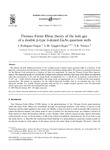
Please use this identifier to cite or link to this item:
http://ricaxcan.uaz.edu.mx/jspui/handle/20.500.11845/628Full metadata record
| DC Field | Value | Language |
|---|---|---|
| dc.contributor | 39945 | es_ES |
| dc.contributor.other | https://orcid.org/0000-0003-0087-8991 | - |
| dc.coverage.spatial | Global | es_ES |
| dc.creator | Rodríguez Vargas, Isaac | - |
| dc.creator | Gaggero Sager, Luís Manuel | - |
| dc.creator | Velasco, Víctor | - |
| dc.date.accessioned | 2018-08-13T14:29:13Z | - |
| dc.date.available | 2018-08-13T14:29:13Z | - |
| dc.date.issued | 2003-07 | - |
| dc.identifier | info:eu-repo/semantics/publishedVersion | es_ES |
| dc.identifier.issn | 0039-6028 | es_ES |
| dc.identifier.uri | http://hdl.handle.net/20.500.11845/628 | - |
| dc.identifier.uri | https://doi.org/10.48779/q38n-s535 | - |
| dc.description.abstract | We present the hole subband structure of two coupled p-type d-doped GaAs quantum wells as a function of the impurity concentration and the distance l between them, including exchange effects. We present an analytical expression for the Hartree–Fock potential as a function of these two magnitudes, by using the Thomas–Fermi–Dirac approximation. The numerical results for a double Be-d-doped GaAs quantum well show that many body effects are important when the concentration is low and the energy levels are degenerate for lP100 AA and an impurity concentration of 5 · 1012 cm 2, while without exchange effects the energy levels are degenerated for lP150 AA and the same impurity concentration. We present an expression for the relative electronic mobility, that is, we calculate the ratio of the electronic mobility of a double d-doped quantum well and that of a simple d-doped quantum well. The theoreticalresults agree quite well with the experimental data available. 2003 Elsevier Science B.V. All rights reserved. | es_ES |
| dc.language.iso | eng | es_ES |
| dc.publisher | Elsevier | es_ES |
| dc.relation.uri | generalPublic | es_ES |
| dc.rights | Atribución-NoComercial-CompartirIgual 3.0 Estados Unidos de América | * |
| dc.rights.uri | http://creativecommons.org/licenses/by-nc-sa/3.0/us/ | * |
| dc.source | Surface Sciencie, Vol. 537, No. 1–3, 1 Julio 2003, Pág. 75-83 | es_ES |
| dc.subject.classification | CIENCIAS FISICO MATEMATICAS Y CIENCIAS DE LA TIERRA [1] | es_ES |
| dc.subject.other | Surface electronic phenomena (work function, surface potential, surface states, etc.) | es_ES |
| dc.subject.other | Quantum wells | es_ES |
| dc.subject.other | Gallium arsenide | es_ES |
| dc.title | Thomas–Fermi–Dirac theory of the hole gas of a double p-type d-doped GaAs quantum wells | es_ES |
| dc.type | info:eu-repo/semantics/article | es_ES |
| Appears in Collections: | *Documentos Académicos*-- UA Física | |
Files in This Item:
| File | Description | Size | Format | |
|---|---|---|---|---|
| Thomas Fermi Dirac.pdf | 153,26 kB | Adobe PDF |  View/Open |
This item is licensed under a Creative Commons License
